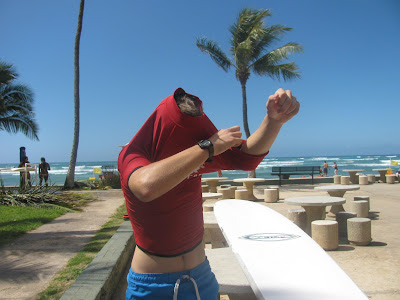Thursday, for his birthday, I took Ben to a surfing lesson.
The first thing we learned was not to follow the GPS's directions on how to get there. We wound up in some top secret military area, and they radioed around that there was a strange car with strange folks in it and a man with very few teeth flagged us down and led us out of there and sent us in the correct direction.
How embarrassing.
 The third thing we learned was that Ben put the rash guard on backwards.
The third thing we learned was that Ben put the rash guard on backwards.
 Rash guards fit like a second skin. They are very tight, like spandex. It is very amusing to watch someone try to take one off, turn it around, and then get back into it.
Rash guards fit like a second skin. They are very tight, like spandex. It is very amusing to watch someone try to take one off, turn it around, and then get back into it.
 Ben's instructor, Dustin, showed him how to paddle. Paddling is very important as it takes up a large portion of your time (and energy) in surfing. It takes a looooong time to paddle out to your starting point for a 5 or 6 second ride on a wave.
Ben's instructor, Dustin, showed him how to paddle. Paddling is very important as it takes up a large portion of your time (and energy) in surfing. It takes a looooong time to paddle out to your starting point for a 5 or 6 second ride on a wave.
 Dustin showed Ben the proper way to stand. You bring your dominant foot forward as far as you can. Then stand up as quickly as you can - without falling.
Dustin showed Ben the proper way to stand. You bring your dominant foot forward as far as you can. Then stand up as quickly as you can - without falling.
When you fall, you have to make sure you "land shallow". The ocean floor at this beach is about 70% rock, 30 % sand. You've got a much greater chance of hitting rock than sand when you fall. Dustin strictly warned Ben not to do anything remotely similar to a dive. He was instructed to do something similar to a belly flop.
Ben had several waves that just petered out on him, several really spectacular falls, and then finally, on his last two attempts, he managed to stay upright until the wave gave out.
The first thing we learned was not to follow the GPS's directions on how to get there. We wound up in some top secret military area, and they radioed around that there was a strange car with strange folks in it and a man with very few teeth flagged us down and led us out of there and sent us in the correct direction.
How embarrassing.

Ben likes this picture because the palm tree behind him makes it look like he has a green mohawk.
 The third thing we learned was that Ben put the rash guard on backwards.
The third thing we learned was that Ben put the rash guard on backwards. Rash guards fit like a second skin. They are very tight, like spandex. It is very amusing to watch someone try to take one off, turn it around, and then get back into it.
Rash guards fit like a second skin. They are very tight, like spandex. It is very amusing to watch someone try to take one off, turn it around, and then get back into it. Ben's instructor, Dustin, showed him how to paddle. Paddling is very important as it takes up a large portion of your time (and energy) in surfing. It takes a looooong time to paddle out to your starting point for a 5 or 6 second ride on a wave.
Ben's instructor, Dustin, showed him how to paddle. Paddling is very important as it takes up a large portion of your time (and energy) in surfing. It takes a looooong time to paddle out to your starting point for a 5 or 6 second ride on a wave. Dustin showed Ben the proper way to stand. You bring your dominant foot forward as far as you can. Then stand up as quickly as you can - without falling.
Dustin showed Ben the proper way to stand. You bring your dominant foot forward as far as you can. Then stand up as quickly as you can - without falling. When you fall, you have to make sure you "land shallow". The ocean floor at this beach is about 70% rock, 30 % sand. You've got a much greater chance of hitting rock than sand when you fall. Dustin strictly warned Ben not to do anything remotely similar to a dive. He was instructed to do something similar to a belly flop.
But he was completely exhausted after an hour of paddling against those waves. This is going to be some serious exercise!


Comments
Post a Comment